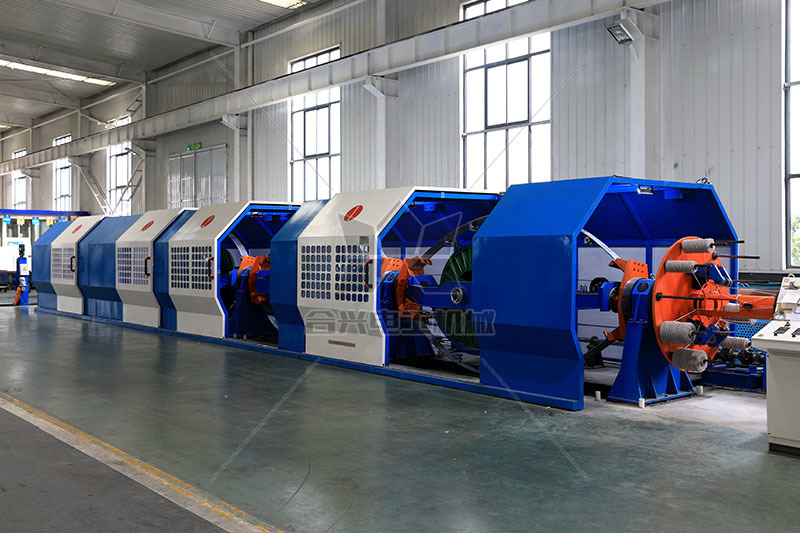How Tubular Stranders are Transforming the Wire and Cable Manufacturing Industry
Release time:
2025-05-19
Tubular stranders are specialized machines used in the wire and cable manufacturing industry to produce stranded conductors

1. Introduction
In the ever-evolving world of wire and cable manufacturing, **tubular stranders** have emerged as a groundbreaking innovation that significantly enhances production processes. These advanced machines are designed to twist together multiple wire strands to create **cables** that meet the rigorous demands of various industries. As manufacturing needs become more complex, tubular stranders provide the necessary technology to improve efficiency, quality, and cost-effectiveness in cable production.
2. What Are Tubular Stranders?
Tubular stranders are specialized machines used in the wire and cable manufacturing industry to produce stranded conductors. Unlike traditional stranding machinery, tubular stranders feature a tubular design that allows for better strand handling and increased flexibility. These machines can handle a variety of wire materials, including copper, aluminum, and composite materials, making them incredibly versatile for different applications.
The key components of a tubular strander include:
- **Feeding System**: Manages the input of wire strands.
- **Stranding Zone**: Where the actual stranding process takes place.
- **Take-Up System**: Collects the finished stranded cable.
The design of tubular stranders allows for a more compact and efficient operation, reducing space requirements in manufacturing facilities and streamlining the production workflow.
3. Historical Evolution of Wire and Cable Production
The history of wire and cable production dates back to the mid-19th century, when the need for reliable electrical conductors surged alongside the industrial revolution. Early machines were rudimentary, often relying on manual labor for tasks that are now automated. Over the decades, advancements in technology led to the development of more sophisticated machines, culminating in the introduction of tubular stranders.
The evolution from simple winding techniques to highly automated tubular stranders reflects the industry's response to increasing demand for high-quality, durable cables. Today, manufacturers are challenged to produce cables rapidly while maintaining stringent quality standards, and tubular stranders meet this need effectively.
4. Advantages of Tubular Stranders in Production
The introduction of tubular stranders has significantly transformed the wire and cable production landscape. Here are some key advantages:
4.1 Enhanced Efficiency and Productivity
One of the primary benefits of using tubular stranders is the **enhanced efficiency** they bring to the production process. These machines can operate at higher speeds compared to traditional stranding equipment, allowing manufacturers to produce more cables in a shorter amount of time. Additionally, the automated features of tubular stranders minimize manual intervention, reducing the likelihood of errors and increasing overall productivity.
4.2 Cost-Effectiveness of Tubular Stranders
Investing in tubular stranders can lead to significant cost savings for manufacturers. The streamlined processes reduce labor costs and minimize material waste, resulting in lower production expenses. Moreover, the durability and reliability of tubular stranders lead to fewer breakdowns and maintenance costs, contributing to a more cost-effective manufacturing operation in the long run.
4.3 Quality Improvement in Cable Manufacturing
Quality is paramount in cable production, and tubular stranders excel in this aspect as well. The precision engineering of these machines ensures uniform tension and accurate stranding, resulting in cables that meet or exceed industry standards. Improved quality not only enhances the performance of the cables but also boosts customer satisfaction and loyalty.
5. Applications of Tubular Stranders in Various Industries
Tubular stranders are utilized across a range of industries due to their versatility and efficiency. Some key applications include:
- **Telecommunications**: For manufacturing high-performance cables used in data transmission and connectivity.
- **Energy Sector**: Producing cables for power generation and distribution, including renewable energy applications.
- **Automotive**: Stranding wires used in vehicle electrical systems, improving safety and performance.
- **Construction**: Manufacturing cables for residential and commercial wiring, ensuring safety and reliability.
The adaptability of tubular stranders makes them an essential tool for manufacturers looking to innovate and meet diverse industry needs.
6. Buying Guide: Choosing the Right Tubular Strander
When selecting a tubular strander, several factors must be considered to ensure it meets your production requirements:
- **Production Capacity**: Assess the output you need based on your manufacturing goals.
- **Material Compatibility**: Ensure the machine can handle the types of wires you plan to use.
- **Automation Features**: Look for models with advanced automation to enhance efficiency.
- **Budget**: Consider both initial investment and long-term operational costs.
Investing in the right tubular strander can significantly impact your production capabilities, making it crucial to choose wisely.
7. Maintenance Tips for Optimal Performance
To keep your tubular strander operating at peak efficiency, regular maintenance is essential. Here are some tips:
- **Routine Inspections**: Regularly check for wear and tear on components.
- **Lubrication**: Keep moving parts well-lubricated to reduce friction and wear.
- **Calibration**: Periodically recalibrate the machine to maintain precision in stranding.
- **Training**: Ensure operators are trained on optimal usage and troubleshooting.
A proactive maintenance approach can extend the lifespan of your tubular strander and minimize downtime.
8. Future Trends in Tubular Stranding Technology
As industries continue to evolve, tubular stranding technology is expected to advance further. Key trends include:
- **Smart Technology Integration**: Incorporating IoT and AI for predictive maintenance and performance monitoring.
- **Sustainability**: Developing eco-friendly stranding processes that reduce waste and energy consumption.
- **Customization**: Offering tailored stranding solutions to meet specific customer requirements.
These advancements promise to enhance the capabilities of tubular stranders, making them even more integral to wire and cable production in the future.
9. Conclusion
Tubular stranders represent a pivotal advancement in the wire and cable manufacturing industry. Their ability to enhance efficiency, reduce costs, and improve quality makes them indispensable for modern manufacturers. As technology continues to evolve, the role of tubular stranders will likely expand, further revolutionizing the production landscape. Investing in these innovative machines can position manufacturers at the forefront of the ever-competitive wire and cable market.
TAG:
Recommend News
HEXING CABLE MACHINERY
TEL: +86-317-3601666, +86-317-3236119
FAX: +86-317-3618408
E-MAIL: china@hbhxdg.cn
E-MAIL: hbhxdg@gmail.com
WEB: http://www.hbhxdg.cn
ADD: Baoantun Industrial Zone, Hejian City, Hebei Province

